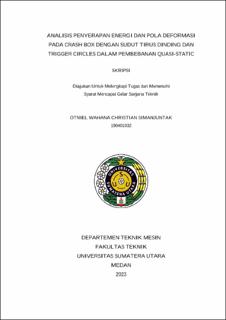| dc.contributor.advisor | Sabri, M. | |
| dc.contributor.author | Simanjuntak, Otniel Wahana Christian | |
| dc.date.accessioned | 2023-10-09T06:49:54Z | |
| dc.date.available | 2023-10-09T06:49:54Z | |
| dc.date.issued | 2023 | |
| dc.identifier.uri | https://repositori.usu.ac.id/handle/123456789/88034 | |
| dc.description.abstract | Crash box is a passive safety system that is used to reduce the severity of accidents experienced by passengers or vital vehicle parts due to collisions. This study examines the effect of variations in the tapered wall angle and trigger circles in a circular crash box on energy absorption and deformation patterns in a quasi-static loading simulation test. The research was conducted using software based on the Finite Element Method (FEM). The variations used in this study are crash boxes with tapered angles of 1° and 5.7° and the location of trigger circles A, B, C and D with Aluminum 6061-T4 crash box material. From the research results it was found that the deformation pattern formed was an axial pattern with a mixed mode (concertina + diamond). Mixed mode deformation occurs in the crash box tapered angle of 1° and 5.7°. The absorption with the greatest ability to absorb energy is in a crash box with a tapered angle (α) of 5.7° of 3124.0 J. | en_US |
| dc.language.iso | id | en_US |
| dc.publisher | Universitas Sumatera Utara | en_US |
| dc.subject | Crash Box | en_US |
| dc.subject | Quasi-Static | en_US |
| dc.subject | Angle Tapered | en_US |
| dc.subject | Trigger Circles | en_US |
| dc.subject | Deformation Pattern | en_US |
| dc.subject | Energy Absorption | en_US |
| dc.subject | SDGs | en_US |
| dc.title | Analisis Penyerapan Energi dan Pola Deformasi pada Crash Box dengan Sudut Tirus Dinding dan Trigger Circles dalam Pembebanan Quasi-Static | en_US |
| dc.type | Thesis | en_US |
| dc.identifier.nim | NIM190401032 | |
| dc.identifier.nidn | NIDN0023066305 | |
| dc.identifier.kodeprodi | KODEPRODI21201#Teknik Mesin | |
| dc.description.pages | 80 Halaman | en_US |
| dc.description.type | Skripsi Sarjana | en_US |


